Gerry Adams's Blog, page 70
February 5, 2013
Acknowledging grief and trauma
The killing of Adrian Donohoe on Friday January 25th sent a shock wave across the island. The young Garda Detective was shot dead only a short distance from his home when a criminal gang carried out an armed robbery of the Credit Union at Lordship.
The Jenkinstown area is a close knit community in the Colley peninsula. Adrian Donohoe was a valued member of that community. He was a keen GAA player both in his home town in Kilnaleck in Cavan and with the local St Patricks GAA club in the Cooleys, where he was both a coach to young kids and a player.
I didn’t know Garda Donohoe personally but many of those I know in the Cooleys liked and respected him. They all spoke of his courage and dedication, his work as a mentor to the youngsters in St. Pat’s GAC and his commitment to his family and community.
The men and women of An Garda Siochána do extraordinarily dangerous work in very difficult circumstances in defence of citizens. They risk their lives and wellbeing to protect society.
The shooting dead of Adrian Donohoe also and understandably evoked memories of the killing of Garda Jerry McCabe and the wounding of Garda Ben O Sullivan in Adare in June 1996. In my remarks in the Dáil I apologised on my own behalf and that of Sinn Féin to those families and to the families of other members of the state forces who were killed by republicans.
I had previously apologised to the McCabe family in May 2007 and again two years later in August 2009 when I described the apology by the men involved in the killing of Garda McCabe as genuine. I said it echoed the sentiments of republicans everywhere. I also expressed my deep regret for the “great loss and hurt suffered by the McCabe and O’Sullivan families.”
Republicans were not involved in the killing of Garda Adrian Donohoe. That much is clear. But there is a need to address the fact that other Gardaí were. That is what I tried to do in a genuine and sincere way.
All of these families, like so many others who were bereaved as a consequence of the conflict, have suffered great pain and loss. Sinn Féin is absolutely determined, as are the vast majority of Irish citizens, to ensure that the recent decades of conflict and the centuries of injustice and violence that preceded it, never ever occur again.
We are equally determined to stand with An Garda Siochána and the PSNI against those who would seek to turn the clock back to the bad days of conflict and in the battle against criminals and criminal gangs.
Regrettably, there have been some who have seen these events as an opportunity to point score against Sinn Féin and to make personalised attacks on me. The Independent Group of newspapers has been especially vitriolic. Every and any pretext is used to write disparaging articles or make offensive comments.
On Monday January 28th the Irish Independent published a particularly bitter and unedifying tirade by columnist Paul Williams. Among other allegations in it he accused me of having worked to “undermine the Gardaí’s work in every way possible.”
I wrote to the Independent. They carried my response although they left out a paragraph which said: “On the contrary I have been very clear in my support for the Gardaí. Since my election as TD I have met with senior Garda officers on a number of occasions as part of my role in supporting their work and on other occasions to report criminal activity. Indeed myself and Conor Murphy, MP for Newry & Armagh met both the PSNI and the Gardaí separately as part of our efforts to tackle cross-border crime.”
Sinn Féin representatives along the border corridor continue this work as our contribution to public safety and community justice. I am very proud to have been elected by the people of Louth to represent them in the Dáil and to lead the Sinn Féin party, whose representatives on both sides of the border work day and daily with both the Gardaí and PSNI for the good of the entire community.
The Independent Group of newspapers have a different agenda. The political bias of the editorial stance is matched only by the vitriol of Indo journalists like Fionnan Sheehan. My apology for the killing of Garda McCabe by republicans also drew the ire of some unionists who in their desire to heap all responsibility for the conflict in the north onto republicans have demanded an apology for the deaths of members of the RUC and British Army.
They make this demand while they reject any suggestion that there should be apologies for the policies of Unionist governments over 50 years; or from the British government, or from unionist leaders, or from those who led the British Army or RUC or UDR or any of the other armed groups associated with the British system; all of whom used or supported the use of violence in furtherance of their own political agenda.
I do not believe the fact that citizens took up arms against oppression in the North, and against those forces that inflicted violence on behalf of the British state, is a matter of apology.
Members of armed groups such as the British Army and the RUC and UDR were active and willing participants in the conflict. So too were the volunteers of the IRA.
Members of An Garda Siochána and the Defence Forces were not combatants.
However, it is important that we should not lose sight of or ignore the hurt and pain of the families of all those who died fighting the war.
No more than we can ignore the deaths and the injuries inflicted on civilians by the British, RUC, UDR, unionist and republican forces.
It is a sad fact of our history that many fell in action. That should give pause for thought to the political elites. It is a shocking indictment of the failure of politics.I take no satisfaction from the killings by the IRA of British soldiers and RUC officers. Whether it is the family of an IRA volunteer, or RUC officer, or the family of a member of the British forces, or of a civilian, or of a victim of sectarianism, or of collusion, they all deserve acknowledgement of the grief and trauma they have suffered.
A one-sided focus on the past takes us nowhere. Addressing complex and painful legacy issues is an enormous challenge.
The conflict is now over. This island and especially the north has been transformed by the Peace Process. There are now power sharing political institutions and a policing service to serve the needs of all citizens.
The priority for all political leaders at this time must be to commit ourselves fully and unequivocally to the Peace Process and ensure that there is never a recurrence of conflict. That is my focus and my commitment.
Reconciliation is an enormous challenge for all of us. There are still significant political differences. None of this will be resolved overnight. It is a process of dialogue, engagement, compromise. There is an onus on the Sinn Féin leadership to promote such a process.
But this is not just a matter for people in the north. There is a particular responsibility also on leaders in this state, in the government and in Fianna Fáil, as well as in the media to deal with legacy issues directly effecting citizens in this state in a way which takes us all beyond invective.
Published on February 05, 2013 14:44
January 31, 2013
Young Scientists of the Future

Young Scientist Exhibition
Two weeks ago I spent a very enjoyable couple of hours visiting this yearsYoung Scientist and Technology Exhibition which was being held as usual in the RDS in Dublin. The halls were packed full of thousands of young people, from all parts of the island, who were there proudly showing off their projects and hoping to win the coveted Young Scientist for 2013 award or one of the other awards that are presented.
This year the event celebrated its 49th birthday. When it first began all those years ago only 230 young people took part. This year over 4,000 students submitted 1800 projects. Less than one in three of the projects submitted made it to the RDS. Despite that over 2,000 young people were there and 79 judges had the difficult task of assessing each of the 550 projects on display.
Louth was well represented with 26 projects from schools across the constituency. I wasn’t able to visit them all but I did get round quite a few, as well as taking the time to meet students from Donegal, Cork, Meath, Dublin and all points of the compass.
The standard of the projects was amazing.
Among those I met were Deirdre Ruane-McAteer and Emma Shields from Bush Post Primary School in Louth. Bush is a DEIS school. These schools exist in areas of social or economic disadvantage and are part of an educational strategy that is about ‘Delivering Equality of Opportunity In Schools (DEIS)’.
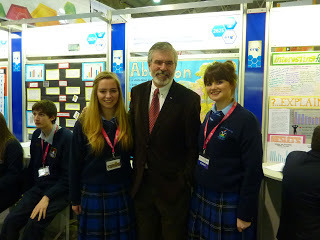 Emma Shields and Deirdre Ruane-McAteer
Emma Shields and Deirdre Ruane-McAteerDeirdre Ruane-McAteer and Emma Shields are two exceptional students who decided to investigate whether the ‘views and opinions of young people living in border counties would differ on the social issue of abortion.’
Their project was entitled: ‘Abortion and Religion: a statistical analysis of views and opinions in border counties.’
This is one of the most difficult issues facing Irish society at this time. The statistical analysis carried out by the two students is a timely social science project into a current and major social issue. The fact that their project was also cross border is an insightful recognition of the need to treat this issue like so many others on an all-island basis.
The two students identified this in the introduction to their project in which they said that: ‘The reason we decided to focus our study on abortion is because we believe that the voice of young people aged between 16, 17 and 18 year olds should be heard and were curious to find out where they stood on the topic. Recent events highlighted in the media such as the case of Savita Halappanavar and the opening of the Marie Stopes Clinic in Belfast reignited the debate and garnered in Ireland negative media attention on an international level.’
The two Bush students succeeded in capturing the runner up group prize in the Young Scientist competition.
Other students from Louth also succeeded in winning praise from the judges.
Among them Áine Grennan and Eimear Shine from St. Louis Secondary School who were Highly Commended in the Biological and Ecological section for their ‘investigation of the impact of human activity on water quality in various coastal locations around Dundalk’.
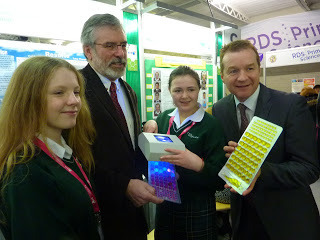
Áine Grennan and Eimear Shine
They had decided as enthusiastic swimmers to carry out an assessment of the water quality of some of the local beaches on Dundalk Bay. Their main aim was to “find out if we swam off any of these beaches would we endanger our health in any way as 20 years ago raw sewage was discharged from an old sewage plant in Dundalk Bay. We wanted to see if there was any raw sewage still left in the bay or has the condition improved since the new Waste Water Treatment Plant was built.”
They discovered that Templetown Beach has a very high water quality while Blackrock had slightly over the Coliform limit but was still acceptable for swimmers provided they exercise caution after bad weather.
Blue Anchor beach however exceeded EU bathing water quality standards “spectacularly” and they warned swimmers that “there are still large quantities of sewage in the sand and high levels of Total Coliforms.”
They have raised the issue with the County Council.
Shane McQuillan, Alex Cahill, and Philip McGuinness, from De La Salle College who were Highly Commended in the Social and Behavioural Sciences for their investigation into ‘the prevalence of racism and sectarianism among teenagers in Dundalk’;
Conor Begley from ColáisteRís who was Highly Recommended in the Technology section for his development of equipment to alert farmers and others to toxic gas in slurry – ‘E.W.O.C.H2: early warning of concentrated hydrogen sulphide’.
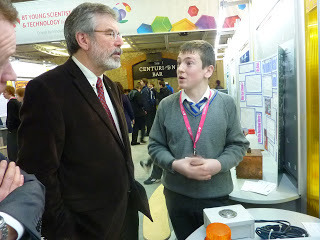
Conor Begley
Last week the importance of Conor’s work was underlined at the inquest into the deaths in September of Noel Spence and his two sons Nevin and Graham who were overcome with fumes on their farm outside of Hillsborough, in County Down. Pathologist Prof Jack Crane said that the levels of hydrogen sulphide along with other toxic gases were high enough to render the men unconscious.
Helen Cunningham and Anna McEvoy from Our Lady’s College, Drogheda, were category winners in the Biological and Ecological Sciences for their investigation into ‘Horse chestnut trees under attack’.
Everyone who attended the event was hugely impressed by the enthusiasm, diligence and professionalism that all of the young people from all parts of the island of Ireland brought to their projects. The standard was exceptional.
The organisers of the Young Scientist and Technology exhibition and everyone who has made this event such a success are also to be commended. They deserve our thanks for their contribution and commitment to the education and advancement of our young people.
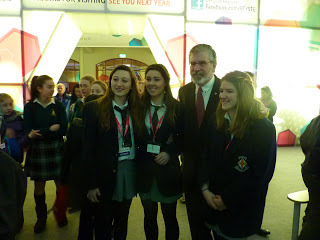
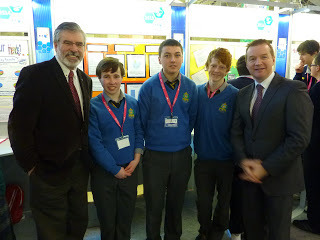
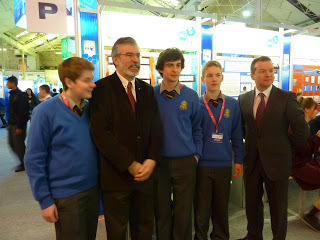
Published on January 31, 2013 16:53
January 24, 2013
Inez McCormack: A Champion for Equality
I have known Inez McCormack for many years. She has been an activist since her days with the People’s Democracy and the Civil Rights Movement in the 1960’s. She took part in the Peoples Democracy march from Belfast to Derry at the beginning of January 1969 which was ambushed by unionists at Burntollet. It was an experience which helped shape the young Inez into the committed activist for equality and justice we all came to know.
Inez described herself as a young Protestant girl who up to that point didn’t realise the depth of injustice and inequality in the north and the extent of structured discrimination confronting Catholics.
Growing consciousness of this injustice spurred Inez to embark on the long march for justice and equality, and in defence of the rights of citizens. Inez was still on that march when she died earlier this week. She remained steadfast and as committed and unswerving to her personal vision throughout those 50 years of activism as she was in 1969.
Inez was a hero – a champion of the oppressed and disadvantaged wherever they were to be found. She never gave up. She never wavered in her absolute belief in the right of women to equality; of workers to parity and fairness, and freedom from exploitation; and of communities to live free from sectarian harassment.
As a young social worker in west Belfast she was suspended from her job because she spoke out against the way in which disadvantaged people were being treated by the system.
It was that courage to take a stand that marked her out throughout her years of tireless campaigning – a willingness to step up, provide leadership and speak out against prejudice.
Inez was also an internationalist from her time marching against the Vietnam War to her opposition of apartheid in South Africa.
She was also a key player in advocating and winning support for the MacBride Principles campaign in the United States which sought to ensure that U.S. investment in the north bolstered fair employment. She was also a very significant lobbyist in the USA on the issue of jobs provision especially in the use of pension funds.
As a woman she broke new ground by rising to the top in her role as a trade union leader and the first woman President of the Irish Congress of Trade Unions. She was a founding member of the Equal Opportunities Commission, the Fair Employment Agency and she helped establish the Equality Coalition.
In 1993 Inez played a pivotal role in persuading the then Irish President Mary Robinson to visit west Belfast. This was a moment of singular importance in breaking through the wall of exclusion that had been built around Sinn Féin and the people of west Belfast. The British policy was to marginalise and disenfranchise republicans and the community within which we lived and from which we drew our support. One British Secretary of State had described west Belfast as the ‘terrorist community’.
The British didn’t want Mary Robinson to visit west Belfast and the Irish government wasn’t much better. But she did and it was one of several key moments in those years which helped create the context for the peace process. Inez helped make it happen. She was the main conduit between the west Belfast community and the office of the President.
Equality was her watchword. It was also centre stage during the Good Friday negotiations in which Inez’s advice and support for anti-discrimination language, human rights and equality came to the fore. A measure of this can be gleaned from the fact that there is no mention of equality in the Sunningdale Agreement in 1973.
It is included 21 times in the Good Friday Agreement.
Post the Good Friday Agreement Inez worked energetically to make its commitment to equality a reality. Her life of activism is marked by the inspirational effect she had on low paid women workers. From her organising work with domestic and cleaning staff in the Royal in the 70’s and 80’s Inez continued to find practical ways to advance the cause of women workers.
One project she and her trade union colleague Patricia McKeown were central to was the Health Employers Initiative which was part of the West Belfast and Greater Shankill Task Force. It facilitated domestic workers in the Royal to train up for higher paid skilled work while creating job opportunities for others.
This time last year Inez chaired one of Sinn Féin’s Uniting Ireland conferences. Over a thousand people turned out at the Millennium Forum to listen to Martin McGuinness and Basil McCrea UUP MLA, and economist George Quigley. Inez chaired the event with her customary good humour and common sense.
Inez was a passionate and articulate campaigner. She had a deserved international reputation as a human rights activist and was widely respected. She believed in people and in their goodness and decency. She will be greatly missed.
But while Inez may be gone the legacy of her decades of hard work is all around us in the progress that has been made over recent years.
Whenever I met Inez in recent times she always spoke with great delight about her grandchildren. Her face would light up as she recounted tales of her latest visit to Scotland to visit them.
That is how I will remember Inez. Her wide enthusiastic, indomitable smile and her great joy with life and living. And her family.
On behalf of Sinn Féin I want to extend my sincerest condolences to her husband Vincent, her daughter Anne, son-in-law Mark and grandchildren Maisie and Jamie.
Published on January 24, 2013 05:07
January 23, 2013
A Border Poll – Let the people decide
Who would have believed it? Sinn Féin holds a conference in Dublin on Saturday and calls for a border poll in the next term of the Assembly and Oireachtas, and by Tuesday the DUP are supporting it!!!
Of course Arlene Foster backs the idea because she’s convinced that it will deliver the answer she wants. According to the DUP Minister for Enterprise, Trade and Investment its ‘fantasy politics’. Peter Robinson thought I was ‘on medication’ when I did an interview last week arguing for such a poll.
The DUP believe that there couldn’t be a worse time for republicans to call for a border poll. Arlene told Mitchel McLaughlin on the Nolan show, “if you look at all of the polling, indeed the census that has recently been carried out, there is nowhere near a united Ireland coming in the future”.
That’s not quite accurate and I’ll come back to that shortly. However one of the major problems facing the unionists is that their economic argument in support of the union is so full of holes!
So, let’s look at some of the maths; although before we begin a health warning! These are figures produced by the British system which refuses to release all of the financial figures involved.
According to the British Treasury the north costs the British government £23.2 billion a year. Figures from the Department of Finance and Personnel show that the north produces £12.7 billion.
The gap therefore between the British Treasury figure of £23.2 billion and the DFP figure of £12.7 billion is £10.5 billion.
That is the figure the unionists and the British claim is the subvention that is needed to keep the north functioning.
The problem is that if you look closely you discover that over half of that alleged subvention - £5.7 billion - never comes to the north. It is spent by the British government on the British military and wars in Afghanistan; British Debt; and the British Civil list, War Pensions, Royal Travel and palaces, Military Museums and much more. They claim they do it on behalf of the north but in reality the Executive nor citizens here see a penny of it.
That means that on the figures provided by the British themselves the subvention is £4.8 billion. But remember they refuse to provide figures for corporation tax or VAT paid by British and international companies trading here but whose headquarters are in Britain. So, that £4.8 billion is considerably less.
Arlene in her contribution to the Nolan Show exposed her lack of knowledge on this when she denied that the £10 billion British subvention does not include the billions spent of wars and the military and the civil list and so on. She said that this money “has absolutely nothing to do with the subvention that we receive from Westminster.”
Sorry Arlene you are wrong. These figures are direct from the British Treasury.
And now back to the census. For too long there has been a presumption that Protestants are unionist and Catholics are nationalist or republican. It was never that simple. Now, for the first time, statisticians have been able to ask a question about identity. The results are very interesting.
Less than half the population (48%) designated themselves as British and northern Irish or Irish. 40% stated that they had a British only identity.
A quarter (25%) stated that they had an Irish only identity and just over a fifth (21%) had a Northern Irish only identity. That’s 46% with some form of Irish only identity.
Statisticians and politicians will argue over the significance of this. But what is certain is that the north is in transition. It is no longer an orange state.
So where do we go from here? Sinn Féin is an Irish republican party. It isn’t just that we want Irish unity – however important that is – we also want a different kind of Ireland – a genuine Republic based on citizens rights which is inclusive and based on equality.
But this republic has to be genuinely inclusive of those who define themselves as unionist and British. That means we have to have to listen to what unionists have to say. Sinn Féin also needs to spell out in an explicit and unambiguous fashion the core values that will shape our vision of that Republic. These must protect all citizens, including rigorously and unequivocally seeking to protect all identities and traditions.
The Good Friday Agreement is quite explicit on this. It sets out: “principles of full respect for, and equality of, civil, political, social and cultural rights, of freedom from discrimination for all citizens, and of parity of esteem and of just and equal treatment for the identity, ethos, and aspirations of both communities …”
The Agreement also guarantees in the event of a united Ireland that the right of those who define themselves as British will not be affected.
At the end of Sinn Féin’s conference in Dublin on Saturday I said that it is time for a debate; it’s time for a date; it’s time for a border poll.
Well the debate has well and truly begun. One enterprising media outlet, Journal.ie, organised a poll on Saturday on whether or not there should be a border poll. 51% said Yes, 32% said no and 15% didn’t know. But they all thought about it before voting and the comments were flying thick and fast.
The debate must continue. Out of this an informed citizenry will ultimately determine the future shape of this island. That’s democracy. So, let the people decide; let’s have that border poll.
Published on January 23, 2013 05:17
January 12, 2013
No Going Back
Belfast 2013 is not the City I grew up in. In my youth and for much of my adult life Belfast was a place in which nationalists had no rights; a place where sectarianism and discrimination, injustice and inequality were commonplace and exercised as a matter of institutional and political practice.
Tens of thousands of nationalists were denied the vote in local and Stormont elections. They were denied jobs and housing. Any sense of Irishness was prohibited or frowned upon. The Irish language, music and culture were marginalised and the political representatives of northern nationalists had no influence and no power.
Elsewhere in the north the gerrymandering or manipulation of electoral boundaries ensured that local councils, even in those areas like Derry which had clear nationalist majorities, were run in unionist interests by unionist controlled councils. And Belfast was among the worst.
The northern state was an orange state. The Orange Order was the cement that held the political, economic and institutional structures of the state together. Most business people were members of the Order. If you were a unionist and wanted to be a senior RUC officer – you had to be an Orangeman. A judge? You had to be an Orangeman. A successful politician? You had to be an Orangeman.
The legacy of those decades still haunts the north. Sectarianism remains a scourge. The scars of discrimination can be found in the disproportionate numbers of citizens on the housing waiting lists in nationalist areas; in the employment patterns across the six counties where nationalist areas experience the highest levels of unemployment; and in the depth of deprivation. 36 out of the 40 most deprived wards in the north are nationalist.
For unionism the northern state was their state. It didn't matter that some unionists also lived in appalling housing or worked in terrible conditions. The northern state – the Orange state – belonged to them. It gave them a sense of belonging, of cohesion and superiority.
The Peace Process and the Good Friday Agreement have changed all of that.It is a process which has been good for everyone on this island. It is also a process which is irreversible.
The underlying ethos of the Good Friday Agreement is parity of esteem, mutual respect and equality.It is also about change. Any process of change present big challenges. There are those who fear change.They see equality for all citizens as a threat.
Equality is not about one side dominating the other – nor is it about anyone attacking what some describe as unionist culture - it is about all citizens – unionist and nationalist - for the first time since partition being treated with mutual respect and on the basis of equality.
It is about nationalists and unionists, and others, living in a society in which decisions are taken democratically and peacefully.It is about tolerance and inclusivity- not hatred and bitterness.
Symbols, including flags, can be divisive but only if the debate is seen in its narrowest context.
So, Belfast is no longer a unionist city. It is a shared city.It wants to be a modern city. The vast majority of citizens don’t want the old Belfast – they want a new Belfast.
The decision taken by Belfast City Council is part of this. It was a compromise position democratically arrived at. Sinn Féin wanted either no flags, or equality of symbols with both the Union flag and Tricolour flying side by side. Sinn Féin Councillors supported the compromise position of the union flag being flown on a set number of designated days a year.
This compromise position was based on Flags legislation brought forward by the British government and which unionist leaders at the time recommended
This April the Good Friday Agreement will be 15 years old.It too was a compromise between conflicting political positions.
It’s success is to be found in the lives saved; the peace that has been achieved; the power sharing arrangements that are working; and the numbers of young people, who unlike their parents or grandparents, have had no experience of conflict.
So, where do we go from here?
It is clear that there are some among unionism who want to turn the clock back. Who believe that mutual respect means nationalists accepting that the unionist ethos must dominate.
That’s not mutual respect or equality. Nor does it reflect the political and demographic realities of today. 90 years ago the northern state was carved out of the rest of the island on the basis that it provided unionists with what was then believed to be a permanent in-built two thirds majority
In the most recent census figures published just before Christmas less than half of the population designated themselves as being British. 40% said they had a British only identity.
A quarter of citizens stated that they had an Irish only identity while 21% said they had a northern Irish only identity. That’s 46% of the population rejecting a British identity and seeing themselves as Irish.
So, the north is not as British as Finchley – as Margaret Thatcher once claimed – and unionists have to accept that almost half of citizens in the north have a different identity.
Could this gradual change in demographics and in peoples’ opinions be part of the motivation of those who seek to stoke the sectarian fires?
Could the decline in the unionist vote be part of the rational for the response of some unionists to the changes that are taking place?
Playing the orange card – fuelling sectarian divisions - is an old unionist and British tactic used to mobilise unionist opinion and put nationalists in their place.
It is a dangerous tactic which in the past brought pogroms and partition and decades of violence.
The vast majority of the protests taking place around the flag issue are illegal. Most are being organised by BNP, UVF and criminal elements, some of whom are well known drug pushers. They are seeking to exploit this situation for their own ends.
There is an expectation across the community that those who are organising these protests will be subjected to due process and that the protests will be policed in a fair way.
As political leaders on this island reflect on the events of recent weeks it is important to understand that the Good Friday Agreement must not be taken for granted. It requires constant attention and work.
There are important parts of the Agreement still not implemented – for example a Bill of Rights and legacy issues. These matters must be addressed.
After the Massereene attack in 2009 in which two British soldiers were killed Martin McGuinness and Peter Robinson brought together all of the political leaders, church and civic leaders to map out a way forward and to ensure that the tiny minority of voices who want to undermine the progress that has been made do not succeed.
That approach is needed again. The Unionist Forum established by the DUP and UUP may have a role to play but it is limited. Stability and inclusivity and progress are not in the gift of one section of people. Everyone has to be involved.
We need an all-party, cross community response to the flag protests and the violence which has accompanied them. It also needs to address all of the other outstanding issues.
This will be a huge challenge. Republicans do not underestimate the problems involved and in particular the difficulties facing unionism. But there can be no going back. The tiny minorities who want to cling to the past must be rejected. Sectarianism must be tackled and ended. The promise of the Good Friday Agreement for a new society in which all citizens are respected, and where fairness and justice and equality are the guiding principles, has to be advanced.
Published on January 12, 2013 08:25
January 9, 2013
My health matters are my business
I hope you all had a peaceful and enjoyable Christmas and New Year. Despite the rain and cold I spent a relaxing and very pleasant few wet days in Donegal generally unwinding from what had been a busy and full 2012.
At the beginning of 2013 news of hospital treatment I received in New York last July broke following the filing of my itinerary for 2012 by Friends of Sinn Féin with the Justice Department in the USA.
This process is part of our obligations under the Foreign Agents Registration Act. So I always knew that news of my treatment would become public. However my health matters are my business. They are personal and private. Just as they are for all citizens.
Sinn Féin responded to media inquiries and confirmed that in July I had travelled to New York to meet with the new Board of Friends of Sinn Féin. They are a dedicated group of Irish American activists who oversee the work of Friends of Sinn Féin in the USA. In the course of a normal year they organise and facilitate the running of fundraising events.
FOSF was established almost 20 years ago in 1995. Their help and support has been invaluable in facilitating Sinn Féin’s efforts to effectively lobby successive US Presidents and administrations and Congress in support of the Irish peace process and a United Ireland.
As part of a revamping of the organisation a new Board was appointed last year and July was an opportunity to meet them and discuss the ongoing work of the peace process as well as Sinn Féin’s plans to launch a campaign for a border poll in early 2013. I also met others on my visit, including business people.
FOSF were responsible for the cost of my flights and this information was filed as part of the annual accounts provided to the US Justice Department.
I have also been suffering for some years with a painful condition related to my prostate. It is not cancer. While in New York I had a medical consultation. I was told that treatment was necessary and overdue. My doctor in Ireland also advised that I should proceed with the treatment I required.
This involved me staying in hospital overnight. Friends of Sinn Féin did not pay any costs toward this treatment nor was there any cost to the Irish taxpayer.
And that was that. Until some in the SDLP, Fine Gael, Fianna Fáil and the Independent Newspaper Group decided to try and use this to attack me and Sinn Féin.
This is the same Fine Gael and Fianna Fáil who have been about the demolition of public health services to the detriment of citizens and the privatisation of these services for the benefit of their cronies.
The SDLP even had the brass neck to try and claim the mantel of socialist arguing that none of them would use private medical treatment and that no true socialist would!
Sad people they are. I know many citizens of all ages and sexes who have sought medical treatment overseas for illnesses. The best treatment is not always available here. Some have had to run public campaigns to raise the money.
I am for a public health service in Ireland that meets the health needs of citizens. That is for a cradle to the grave universal public health service which delivers top class treatment to everyone.
If anyone wishes to use private health care to address a medical issue that is a matter for them, provided the taxpayer does not pick up the tab. What Sinn Féin is opposed to is the private health care business being subsidised from the public purse and the ongoing privatisation of hospital and other public services.
Finally, can I thank all of those who have wished me well since the news of this broke in the media. I am always uplifted by the kindness and generosity and humanity of people.
Finally, finally, Sinn Féin will be holding a major conference in Dublin in two weeks, on January 19th, to launch our campaign for a border poll. More on that important issue next week.
Published on January 09, 2013 02:16
December 24, 2012
Beannachtaí na Nollag agus Bliain Úr faoi mhaise daoibh
The Music of Protest
Beannachtaí na Nollag agus Bliain Úr faoi mhaise daoibh. Let me wish readers and bloggers and facebookers everywhere a peaceful and happy Christmas and a great New Year.
I like music. And a lot will be played over the Christmas break. I play it all the time. In the car. In the office. At home. I have music on my IPad and my phone. And I like all kinds of music from classical to Irish traditional to folk to rock. Two weeks ago several of us took time out of a mad schedule in the Dáil to walk round to the Olympia for a Kris Kristofferson concert.
It was almost two hours of really good music. Just him and his guitar. With a few sets in harmony with his daughter Kelly and a young man who may have been his son. Many of the songs brought back memories of earlier times and were warmly welcomed by an appreciative audience. He sang all the standards from ‘Me and Bobby McGee’ – which Bobby Sands sang for us in Cage 11 - through ‘Help me make it through the night’ to ‘The Silver Tongued Devil’.
He sang of love, and drink, and friendship and God and politics. His admiration for President Barack Obama stated quietly. His voice is not as strong as it once was – he is 76 – but there was never a wrong note struck or a lyric stumbled over as he worked his way through his extensive back catalogue.
Much of Kristofferson’s best known work is as a performer on his own, although the Highwaymen period with Waylon Jennings, Willie Nelson and Johnny Cash produced great music.
I find, like most people that music is full of memories. Sometimes sad and happy but most often associated with specific times in our lives. It is also a great way to get a message across.
Over the centuries there have been some great songs of protest and resistance. In the USA the abolitionists sang songs of freedom for slaves; the trade union movement internationally has a wealth of songs of resistance; almost every war fought in recent centuries has produced songs of protest and opposition; and almost every campaign for civil and human rights, including the right to vote for women produced songs of solidarity.
In a very real way these are songs and music of propaganda.
Irish music is full of them. I was reminded of this last week when I met Conal Kearney, whose grandfather Peadar Kearney wrote The Soldiers Song, as well as Down by the Glenside (The Bold Fenian Men); The Tri-coloured Ribbon, and Down by the Liffey Side. There have been many others including, ‘The Broad Black Brimmer’, ‘Boolavogue’ and Kevin Barry which was memorably song by the American civil rights activist Paul Robson and also by Leonard Cohen. ‘A Nation Once Again’ song by the Wolfe Tones, was voted the number one song in the world in 2002 by listeners to the BBC’s World Service.
The Bold Fenian Men is a particular favourite. It was written around the time of 1916 and was a potent and evocative call to arms.
Over the years it has been sung by the best, from the Clancy Brothers to the Dubliners, and it even made an appearance in the John Wayne classic Rio Grande. The fact that the film was set in the American west 40 years before the song was written did not diminish the potency of its performance or its message.
‘Some died by the glenside, some died near a stranger
And wise men have told us their cause was a failure
But they fought for old Ireland and never feared danger
Glory O, Glory O, to the bold Fenian men
I passed on my way, God be praised that I met her
Be life long or short, sure I'll never forget her
We may have brave men, but we'll never have better
Glory O, Glory O, to the bold Fenian men’
There have been countless others up to and including the most recent period of conflict with songs like The Men behind the Wire, 90 Miles from Dublin and On the Bridge, by Christy Moore about the women prisoners in Armagh Gaol.
Christmas hasn’t escaped from a mention in protest songs. One of the best is John Lennon’s 1971 anti-war anthem ‘Happy Xmas – War is over’.
Lennon was writing about the Vietnam War but his words from 40 years ago are as powerful today as they were then. From violence on the streets of the north by unionist protestors, to the continuing denial of Palestinian rights in the Middle East, to the Congo and the Sahel region of north Africa and scores of other places around the world, war and hunger and inequality continue to inflict great hurt on millions of citizens.
Lennon’s message was simple and direct:
‘A very merry Christmas
And a happy New Year
Let's hope it's a good one
Without any fear
And so this is Christmas
For weak and for strong
For rich and the poor ones
The world is so wrong
And so happy Christmas
For black and for white
For yellow and red ones
Let's stop all the fight
A very merry Christmas
And a happy New Year’
Beannachtaí na Nollag agus Bliain Úr faoi mhaise daoibh. Let me wish readers and bloggers and facebookers everywhere a peaceful and happy Christmas and a great New Year.
I like music. And a lot will be played over the Christmas break. I play it all the time. In the car. In the office. At home. I have music on my IPad and my phone. And I like all kinds of music from classical to Irish traditional to folk to rock. Two weeks ago several of us took time out of a mad schedule in the Dáil to walk round to the Olympia for a Kris Kristofferson concert.
It was almost two hours of really good music. Just him and his guitar. With a few sets in harmony with his daughter Kelly and a young man who may have been his son. Many of the songs brought back memories of earlier times and were warmly welcomed by an appreciative audience. He sang all the standards from ‘Me and Bobby McGee’ – which Bobby Sands sang for us in Cage 11 - through ‘Help me make it through the night’ to ‘The Silver Tongued Devil’.
He sang of love, and drink, and friendship and God and politics. His admiration for President Barack Obama stated quietly. His voice is not as strong as it once was – he is 76 – but there was never a wrong note struck or a lyric stumbled over as he worked his way through his extensive back catalogue.
Much of Kristofferson’s best known work is as a performer on his own, although the Highwaymen period with Waylon Jennings, Willie Nelson and Johnny Cash produced great music.
I find, like most people that music is full of memories. Sometimes sad and happy but most often associated with specific times in our lives. It is also a great way to get a message across.
Over the centuries there have been some great songs of protest and resistance. In the USA the abolitionists sang songs of freedom for slaves; the trade union movement internationally has a wealth of songs of resistance; almost every war fought in recent centuries has produced songs of protest and opposition; and almost every campaign for civil and human rights, including the right to vote for women produced songs of solidarity.
In a very real way these are songs and music of propaganda.
Irish music is full of them. I was reminded of this last week when I met Conal Kearney, whose grandfather Peadar Kearney wrote The Soldiers Song, as well as Down by the Glenside (The Bold Fenian Men); The Tri-coloured Ribbon, and Down by the Liffey Side. There have been many others including, ‘The Broad Black Brimmer’, ‘Boolavogue’ and Kevin Barry which was memorably song by the American civil rights activist Paul Robson and also by Leonard Cohen. ‘A Nation Once Again’ song by the Wolfe Tones, was voted the number one song in the world in 2002 by listeners to the BBC’s World Service.
The Bold Fenian Men is a particular favourite. It was written around the time of 1916 and was a potent and evocative call to arms.
Over the years it has been sung by the best, from the Clancy Brothers to the Dubliners, and it even made an appearance in the John Wayne classic Rio Grande. The fact that the film was set in the American west 40 years before the song was written did not diminish the potency of its performance or its message.
‘Some died by the glenside, some died near a stranger
And wise men have told us their cause was a failure
But they fought for old Ireland and never feared danger
Glory O, Glory O, to the bold Fenian men
I passed on my way, God be praised that I met her
Be life long or short, sure I'll never forget her
We may have brave men, but we'll never have better
Glory O, Glory O, to the bold Fenian men’
There have been countless others up to and including the most recent period of conflict with songs like The Men behind the Wire, 90 Miles from Dublin and On the Bridge, by Christy Moore about the women prisoners in Armagh Gaol.
Christmas hasn’t escaped from a mention in protest songs. One of the best is John Lennon’s 1971 anti-war anthem ‘Happy Xmas – War is over’.
Lennon was writing about the Vietnam War but his words from 40 years ago are as powerful today as they were then. From violence on the streets of the north by unionist protestors, to the continuing denial of Palestinian rights in the Middle East, to the Congo and the Sahel region of north Africa and scores of other places around the world, war and hunger and inequality continue to inflict great hurt on millions of citizens.
Lennon’s message was simple and direct:
‘A very merry Christmas
And a happy New Year
Let's hope it's a good one
Without any fear
And so this is Christmas
For weak and for strong
For rich and the poor ones
The world is so wrong
And so happy Christmas
For black and for white
For yellow and red ones
Let's stop all the fight
A very merry Christmas
And a happy New Year’
Published on December 24, 2012 07:14
December 18, 2012
A Letter to Enda Kenny
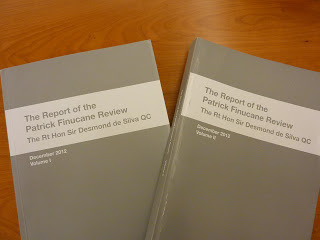 The de Silva Report On Tuesday I raised the de Silva report into Pat Finucane’s killing in the Dáil with the Taoiseach Enda Kenny. I asked that time be made available for a debate on the report. I also wrote to him last week and I asked that the Irish government carry out a trawl of the documents available to it about the threat to human rights lawyer PJ McGrory, as well as to Pat Finucane and Oliver Kelly.
The de Silva Report On Tuesday I raised the de Silva report into Pat Finucane’s killing in the Dáil with the Taoiseach Enda Kenny. I asked that time be made available for a debate on the report. I also wrote to him last week and I asked that the Irish government carry out a trawl of the documents available to it about the threat to human rights lawyer PJ McGrory, as well as to Pat Finucane and Oliver Kelly. I have decided to publish my letter to the Taoiseach in this column. The Pat Finucane case goes to the heart of British state collusion. The detail of what occurred is important if bereaved families and the communities in which they live are to have the fullest understanding of the events of that time.
December 13th 2012
Taoiseach a chara,
As you are aware the British government has not co-operated with the efforts to find justice for families bereaved or for those injured in actions involving their forces or believed to have resulted from collusion between these forces and unionist paramilitaries.
These actions include the Ballymurphy Massacre, the Springhill Massacre, the Dublin Monaghan bombings and the killing of Pat Finucane.
There are other cases involving collusion, these include the killing of three Sinn Féin Councillors John Davey, Bernard O Hagan and Eddie Fullerton who was murdered in his home in Buncrana county Donegal, eleven other Sinn Féin members and 7 of our family members.
You will recall that I have urged you to adopt an approach in some of these cases similar to that employed in the run up to the Saville Inquiry.
That is for your government to compile a file of all relevant information about these cases as a means to persuade the British government to lift the lid on these matters.
I welcome the government’s support for the Finucane family’s call for a public inquiry into the killing of Pat Finucane.
I disagree with the Tánaiste’s assertion that David Cameron should be commended for his determination in seeking the truth about collusion.
The de Silva review was constructed to frustrate the family’s demand for truth. It is a direct breach of the international agreement between the Irish and British government at Weston Park.
Mr. Cameron has said that there was no ‘over-arching State conspiracy’. His statement that the then Attorney-General, Sir Patrick Mayhew, deserves credit for prosecuting British agent Brian Nelson has no credibility.
Nelson is believed to have been involved in at least 15 murders, probably many more and scores of attempted killings.
Far from prosecuting Nelson fully and in order to prevent the detail of Nelson’s role as an agent being scrutinised in court Patrick Mayhew did a deal with Nelson. The murder charges against Nelson were dropped.
It was agreed that Colonel Gordon Kerr, the head of the Force Research Unit, which ran many of the collusion operations, would give evidence supporting Nelson.
The British Minister of Defence Tom King, who was Secretary of State for the north at the time of the killing of Pat Finucane, provided a letter of commendation for Nelson.
And the British Prime Minister John Major held a meeting just before the trial with the north’s Lord Chief Justice Brian Hutton and the trial judge Basil Kelly.
It is clear that there was significant knowledge among senior British Ministers about the role of Nelson, working as an agent of the British government, and that they moved to cover it up.
Later when Patrick Mayhew was Secretary of State for the north the RUC Special Branch ran a UVF gang out of Mount Vernon, led by a Special Branch agent Mark Haddock,that killed at least ten people and possibly others.
Mayhew cannot claim not to have known about collusion.
In addition, the Force Research Unit received at least 74 ‘awards and honours’ for its work from the British government, including an OBE for Colonel Kerr in May 1991, less than two years after Pat Finucane was killed.
Furthermore, before Pat Finucane was killed Belfast solicitor PJ McGrory spoke to me about the threat to his life. He told me that the UDA was saying that the RUC was putting it under pressure to kill himself, Pat Finucane and Oliver Kelly.
PJ told me he briefed the Irish government who said they would raise it with the NIO.
Hours after Pat Finucane was killed an Irish government official was in PJ’s home speaking to him about the threats.
The then Taoiseach Charlie Haughey phoned and told PJ that he would take this matter up with Downing Street.
In keeping with my suggestion about compiling a file, the Irish government should now initiate an extensive examination of all documents in the Department of the Taoiseach, Foreign Affairs and Justice relating to the north and identify those which could assist the family in refuting the British government’s effort to frustrate the Finucane family’s demand for a public inquiry.
Is there a record of PJ’s conversation with the Taoiseach and with other departmental officials?
Did the Taoiseach, Mr. Haughey, raise this matter with Downing Street or the NIO?
What information has the government on the many allegations of collusion than were being made then and since?
Did the Irish government or any of its agencies speak to the British government or its agencies?
Taoiseach, the Irish government needs to shift into a higher gear in support of the family.
A strategic approach is required that would see the government use its diplomatic services across the globe and its influence in the USA, in the EU and at the United Nations, where the Irish government now sits on the Human Rights Council, to win support for the Finucane family.
I look forward to your reply.
Is mise
Gerry Adams TD
Published on December 18, 2012 11:32
December 14, 2012
Stories of hope and courage
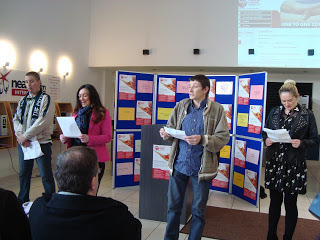
Telling their Story
One of the great pleasures in my work is that I get the opportunity to meet ordinary men and women, usually working in the community and voluntary sector, whose commitment to a cause or a project saves lives.Last Thursday morning I was in the Civic Centre at Coolock in north Dublin. I had been invited to speak at the launch of a new website and CD – ‘Voices’ – by the Laneway Learning Centre Community Drugs Rehabilitation Programme (RASP) which are about raising awareness of drug addiction.
But what makes this project innovative and special is its use of drama and music as a means of encouraging recovering addicts to examine their lives and to look to the future with optimism.
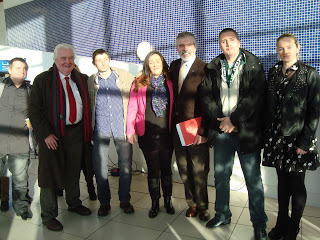 Conal Kearney, whose grandfather Peadar Kearney wrote Amhrán na bhFiann, as well as Down by the Glenside (The Bold Fenian Men); The Tri-coloured Ribbon, and Down by the Liffey Side, uses drama therapy and it is evident from the enthusiasm of the ten methadone maintenance participants, that it works.
Conal Kearney, whose grandfather Peadar Kearney wrote Amhrán na bhFiann, as well as Down by the Glenside (The Bold Fenian Men); The Tri-coloured Ribbon, and Down by the Liffey Side, uses drama therapy and it is evident from the enthusiasm of the ten methadone maintenance participants, that it works.Conal Kearney, whose grandfather Peadar Kearney wrote Amhrán na bhFiann, as well as Down by the Glenside (The Bold Fenian Men); The Tri-coloured Ribbon, and Down by the Liffey Side, uses drama therapy and it is evident from the enthusiasm of the ten methadone maintenance participants, that it works. The ten tell a story. They recall a happy childhood memory, their worst memory as a drug user and then their effort to lift themselves out of that dark place into a space where there is hope.
Four of the participants read extracts from the stories that are told.
John remembered a happy memory when he was 11 years old: “I got a red mountain bike for Christmas. See I knew that it was a bike because I saw my brother getting it out of the car and putting it upstairs in one of the bedrooms months before. They told me it was a snooker table, but I knew that it wasn’t because there were no cues. Me Ma locked the doors upstairs to make sure I didn’t get a look. She didn’t know that I had a key so when I had the gaff to myself I had a look at the lovely red mountain bike: ten speed as well. I put the axle on some books so I could test the gears, but it was no good. I put the beds on their sides and cycled it around upstairs just to use the gears. I got some scratches on the bike. I had to act all surprised on Christmas morning.”
Karen recalled a bleak violent point in her life: “One summers evening I went down to the Donnybrook to score my coke and gear. I lived in Rialto so it was only a ten minute drive, my dealer lived in a row of houses which had a lane in the back of them and that’s where I would meet him. I always got the taxi to wait at the end of the lane but this time I didn’t. It was starting to get dark, so I decided to cut through Herbert Park just thinking of getting my coke and gear into me. Suddenly I was grabbed from behind and dragged into a row of bushes. I hit, screamed, kicked, punched. I thought he was looking for my drugs but he wasn’t. He was trying to rape me. He pushed me to the ground, ripped off my top but all I was worried about was losing my drugs. He had me pinned to the ground saying repeatedly ‘stay still bitch’, ‘you will do as I say’. Luckily I got the chance to scream, my attacker hit me one last time as he fled.”
Their stories of hope were inspiring. Rachel described how her life “changed the day I left the hospital after nearly losing my leg. I realised that enough was enough and I want my life back. After a year being clean from street drugs I applied for a place in the educational programme here at RASP and was accepted. Before I started I had no confidence or belief in myself. After a while doing the courses I realised that I had intelligence and that I could make a life for myself …”Mary recalled that the last time “I was in Beaumont hospital my survival was placed at fifty/fifty. I didn’t realise how bad I was but I was still craving drugs. The drugs that I had put into my body heroin, crack and crystal meth had taken their toll. I realised I was going nowhere and it was time to stop. I became clear headed and applied for a place in RASP. After three months of giving clean urine I was given a place. I am now on the programme nine months and am stable …everyday is a struggle but I am learning what to do and not to do to aid my recovery …”
All of them praised RASP and described their struggle to battle addiction and the help they received from RASP and their families.
They were surrounded by their family and friends at the event and were being applauded and cheered on to tell their stories. They were as brave and courageous a group of people as any I have met in many years.
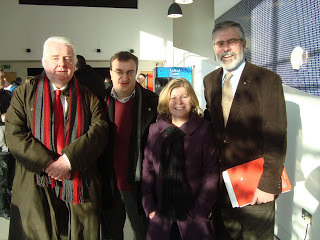 Councillor Larry O'Toole; Councillor Micheál McDonncha and Denise MitchellGroups like RASP are vital. They provide the extra push, the education and information that can make all the difference to someone wanting to end their addiction.
Councillor Larry O'Toole; Councillor Micheál McDonncha and Denise MitchellGroups like RASP are vital. They provide the extra push, the education and information that can make all the difference to someone wanting to end their addiction.The website and the CD are important additional tools for those trying to provide support.
Of course, the reality is that there are many homes in Ireland that are or have had to cope with the problem of drug and alcohol addiction.
These drugs may be legal or illegal, prescribed or non-prescribed. But in most cases the addiction is tackled and the families, with difficulty and help, continue to live a largely normal life. But in some cases the addiction becomes a crisis. This manifests itself most clearly in the bald statistics of drug related deaths.
This state has one of the highest rates for drug related deaths in Europe. According to recent statistics these are twice the European average of deaths. The U.N.s World Drug Report for this year revealed that while the use of heroin is levelling out elsewhere in Europe, only in Sweden and in this state are prevalence rates increasing.
Different drugs and the misuse of alcohol will have different effects on different people. Drug addiction can also have a very negative effect on the wider community.
Drug addiction becomes a community drug problem when drug pushers increase their activity; when public areas become unsafe and are associated with drug related behaviour; when citizens suffer intimidation and threats of violence and violence are used.
This rarely happens in isolation of other contributing factors; high unemployment, poverty, dependency on social welfare, poor housing conditions, lack second and third level education, and inadequate drug awareness programmes, all contribute to creating a community drugs problem.
It is also important to note that drug misuse is not restricted to working class or disadvantaged areas. It cuts across all social classes.
A reduction in funding to education and drug awareness programmes; cutbacks to new build or renovation projects for housing and to education, health and social welfare programmes ; to youth training projects; and to public services, all contribute to making the situation worse.
Effectively tackling the drug addiction problem requires a holistic approach by all of the statutory bodies, including the Gardaí and local councils and government, and local communities, working to an agreed strategy.
It requires a partnership approach, especially on an all-Ireland basis. This is the only way we can make progress in ridding our communities of this scourge.
But seeking help and support is the first important step in tackling addiction. Any of us could become an addict. Those brave souls, like our friends in Kilbarrack, who find the ability to overcome their addiction are proof that it can be done. They are heroes.
RASP: Laneway Learning Centre can be contacted at Unit 1 Belcamp Business Park, Belcamp Lane, Dublin 17
www.raspprogramme.com
Tel 01 8674060

Published on December 14, 2012 03:22
December 9, 2012
Pat Finucane – a remarkable, extraordinary and courageous Irishman
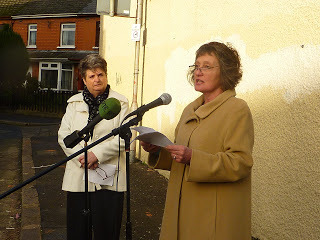 Geraldine Finucane
Geraldine Finucane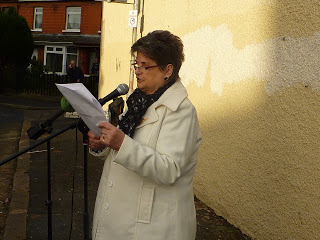 Clara Reilly of Relatives for Justice
Clara Reilly of Relatives for JusticeOn Wednesday the de Silva review into the papers linked to the killing in 1989 of Belfast human rights lawyer Pat Finucane will be published. Today a mural to Pat Finucane was unveiled in west Belfast by Pat's wife Geraldine. Pat was killed by a unionist death squad in collusion with British state forces. I was asked to speak. "I want to thank Geraldine, John, Michael and Katherine and the entire Finucane family for the invitation to speak today at the unveiling of this plaque to a very remarkable and courageous Irishman.
Some people measure heroes and bravery by their ability to be warriors in the physical conflict of war. But there are also those whose courage is of a different kind, of an extraordinary kind.
Pat was such a person. He believed in the law. More so than the elites in the parliament in London and elsewhere who make and bend and break the law at will.
He came from a working class background. He and I went to the same school, St. Finian’s on the Falls Road.
Pat went on to be a good, conscientious solicitor who worked long difficult hours, under trying conditions, representing his clients.
He was a lawyer working within a unionist and Orange dominated legal and judicial process that had been corrupted by years of British manipulation and an arsenal of new and ever more repressive laws.
All of these were designed to maximise the power of the state and reduce the rights of citizens. Pat worked tirelessly against this injustice. He constantly challenged the abuses of the state by seeking to use the law positively.
But this devotion to human rights, Pat’s diligence and his success, also made him a figure of hate within the RUC and the British system. They plotted against him.
On February 12th 1989 two masked gunmen forced their way into the family home in North Belfast. Pat was shot repeatedly. Geraldine was wounded in the attack.
And the RUC and the British they thought that was it. They thought they had silenced a good man, a brave man. That they could continue unimpeded in their use of agents and death squads. But they reckoned without Geraldine.
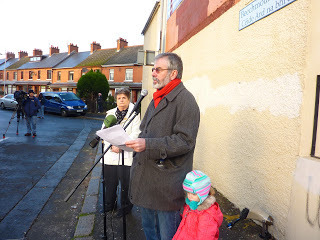 The Finucane family have been responsible for one of the most effective and protracted justice campaigns ever mounted by a family against the might of the British system and its apologists.
The Finucane family have been responsible for one of the most effective and protracted justice campaigns ever mounted by a family against the might of the British system and its apologists.I believe that Pat would be enormously proud of Geraldine and his family and their tenacity in the face of efforts by the British government to silence them. He would also be immensely proud of how Geraldine reared their two fine sons and their beautiful daughter.
The reason the British have worked so hard to avoid a public inquiry is because this case goes to the heart of British state collusion with unionist death squads.
The Pat Finucane case, through its disclosure of the connections between the British government, its military and intelligence agencies, the RUC and unionist deaths squads, exposes the use of those death squads at the highest level of government; its involvement in the mass murder of citizens, and in the smuggling of weapons to facilitate this.
Collusion was not just the occasional use of spies or agents by the British operating within the IRA or loyalist paramilitary organisations.
Collusion was a matter of institutional practise by successive British governments.
It involved the establishing of unionist paramilitary groups; the systematic infiltration by the British of all unionist death squads at the highest levels; controlling and directing these groups; arming; training; and providing them with information on people to be killed.
It also involved protecting them and when occasionally they were caught arranging for deals to minimise any court decisions.
The architect of this policy explained it best.
Brigadier (later General) Frank Kitson took command of the 39th Brigade, which covered the Belfastarea in 1970. Kitson was the British Army’s foremost expert on counter-insurgency.
He argued that all governmental structures, the judiciary, the law, the police and the media had to become part of a co-ordinated strategy and that all government policies, whether social, economic, cultural, infrastructural, had to be moulded to suit the aim of defeating the enemy and suppressing citizens and our rights.
Kitson wrote: ‘The fundamental concept is the working of the triumvirate, civil, military and police, as a joint and integrated organisation from the highest to the lowest level of policy making, planning and administration.’
But more significantly in light of the killing of Pat Finucane and countless others, Kitson explained the use of death squads and the corruption of justice: ‘Everything done by a government and its agents in combating insurgency must be legitimate.
But this does not mean that the government must work within exactly the same set of laws during an emergency as existed beforehand.
The law should be used as just another weapon in the government’s arsenal, in which case it becomes little more than a propaganda cover for the disposal of unwanted members of the public.’
This doesn’t mean that all loyalists are dupes. They have their own agenda, much of it anti-Catholic and based upon sectarian hatred or fears. But the war aims of both were similar and so it made for an easy alliance.
British agencies helped establish the UDA and re-organise the UVF.
New secret organisations like the Military Reaction or Reconnaissance Force (MRF) were established to foment sectarian violence and in 1982 the Force Research Unit was set up within the British Army Intelligence Corps.
One of the first people to be recruited by FRU was loyalist Brian Nelson. He was a former British soldier who had joined the UDA in 1972 and was convicted in 1974 of the kidnapping and torture of a partially sighted Catholic man Gerald Higgins. Nelson served just over 3 years in prison for this.
He was recruited by FRU in 1983 and was told to rejoin the UDA. Two years later he was appointed the UDA’s Intelligence Officer in its West Belfast Brigade. Essentially his job was to gather intelligence information on potential republican targets.
Later he became the UDA Senior Intelligence Officer for the entire organisation. His associates in FRU helped him to update his intelligence files.
In 1985 he was involved in the negotiation of arms from the South African apartheid regime. In return for money, and missile parts obtained from the huge military production plant at Shorts in East Belfast, the apartheid regime facilitated a massive arms shipment.
FRU was kept informed of all of this. The British Secret Service was across the detail. And in late 1987/early 88 an arms shipment arrived here consisting of 200 AK47 automatic rifles, 90 Browning pistols, 500 fragmentation grenades, ammunition and 12 RPG rocket launchers. The shipment was divided up between the UDA, UVF and Ulster Resistance.
The impact of this weapons shipment can be found in the statistics of sectarian attacks and killings which occurred in subsequent years.
In the three years prior to receiving this weapons shipment the unionist death squads had killed 34 people. In the three years after the shipment they killed 224 and wounded countless scores more.
The dramatic rise in the number of Sinn Féin activists and family members being killed can be traced directly to this fact and to the information FRU and the Special Branch were passing on to their agents within the loyalist death squads.
In the following years three Sinn Féin Councillors, 11 party activists, and 7 family members, including brothers, sons, spouse and partners were killed. Many others were seriously wounded.
Republican homes and Sinn Fein offices became the frequent targets of attack by loyalist death squads.
The role of Brian Nelson and in particular of Brigadier Gordon Kerr (Colonel J ) who ran the Force Research Unit, are particularly important in all of this.
Pat’s death came less than four weeks after Conservative government Minister Douglas Hogg MP, then Parliamentary Under-Secretary of State for the Home Department, in a Committee Stage debate on the Prevention of Terrorism (Temporary Provisions) Bill on 17 January 1989 said:
"I have to state as a fact, but with great regret, that there are in Northern Irelanda number of solicitors who are unduly sympathetic to the cause of the IRA.”
And after Pat’s death as more and more information emerged we learned that Tommy Lyttle, the leader of the UDA group that carried out the killing was a Special Branch agent;
Ken Barrett, the man who was convicted of killing Pat Finucane was a Special Branch agent; William Stobie, the UDA man who supplied the gun used was a Special Branch agent; and Brian Nelson who provided the information was working for FRU.
The family demanded a full public inquiry. The British resisted.
At Weston Parkin 2001, 12 years after Pat was killed, the British government, in an effort to avoid an inquiry into the killing of Pat agreed with the Irish government to invite Judge Peter Cory to determine the need for inquires in a number of cases. The aim was to long finger the Finucane families demand.
In April 2003 John Stevens in his third report confirmed that he had evidence that there was collusion in the killing of Pat Finucane.
There was also a cover-up, consistent and deeply subversive and the destruction of evidence by the British system.
In 2004 Judge Cory concluded that there should be an inquiry into Pat’s killing.
The British moved to pass a new law – the Inquiries Act - giving Ministers the power to block evidence.
Judge Cory accused the British of moving the goalposts. He said: ‘It’s like playing hockey and instead of six to each team you have one team with eight and one with four. See how your doing for ten minutes and then in the middle of everything you move the goalposts and you change the rules of the game.’
Lord Saville who chaired the Bloody Sunday inquiry criticised the British government’s decision. He warned that giving a government Minister the power to block evidence would make ‘a very serious inroad into the independence of any inquiry and is likely to damage or destroy public confidence in the inquiry and its findings…
As a judge, I must tell you that I would not be prepared to be appointed as a member of an inquiry that was subject to a provision of this kind.’
Last year the family met David Cameron after months of protracted discussions in the expectation that he was about to provide for the type of inquiry they were demanding.
Instead he told them that he was ordering a review of the papers in the case by Desmond de Silva QC. This was a repudiation of the agreement between the British and Irish governments. The Irish government should have prevented this.
The family were understandably furious by David Cameron’s action.
· This was not the public inquiry promised at Weston Park.
· It was and is not independent and transparent.
· It is the British Tory government investigating the British Tory government.
· The family have been kept in the dark since de Silva commenced his review.
The day after David Cameron rejected the families demand the British Secretary of State, speaking in the British Parliament, accepted the Stevens report of 8 years earlier that Pat Finucane was killed as a result of collusion.
But what they remain desperate to avoid is for the depth of that collusion to become public or that it was cleared at the highest political levels, including Downing Street.
The role of the Irish government in all of this has not been helpful, strategic or as consistent as it could be.
The British government are in breach of an agreement with the Irish government. The Taoiseach has repeatedly said that he wants the British to fulfil their Weston Park Commitment but he has done little about it although I have raised this with him regularly in the Dáil.
However, apart from an occasional conversation with David Cameron on the margins of meetings there has been no consistent, planned strategy by the Irish government to mobilise international and diplomatic support for this.
This is not good enough. Whatever the outcome of the de Silva review all of us have a duty to fully support the Finucane family’s response to it. The family demand for a full, transparent and accountable public inquiry is a reasonable demand.
We wish Geraldine and her children well in these difficult times. You know you can rely on Pat’s siblings and his close colleagues, Peter and others, who have walked with you through all the challenges on your journey in search of justice for Pat.
You should also know that all those citizens in this country and in Britain and the USA and around the world who have supported them over the last 23 years of campaigning will continue to do so.
That’s the least we can do.
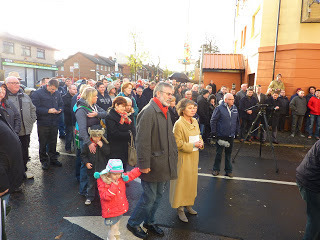
Published on December 09, 2012 09:14
Gerry Adams's Blog
- Gerry Adams's profile
- 29 followers
Gerry Adams isn't a Goodreads Author
(yet),
but they
do have a blog,
so here are some recent posts imported from
their feed.



